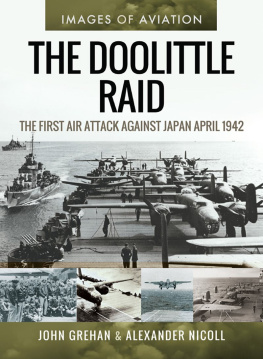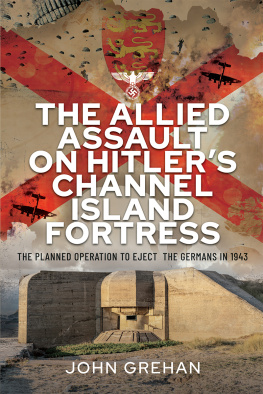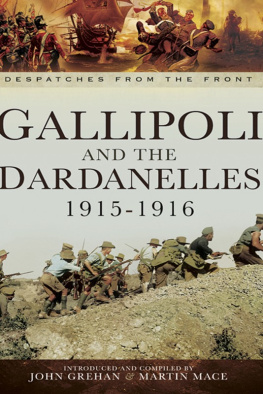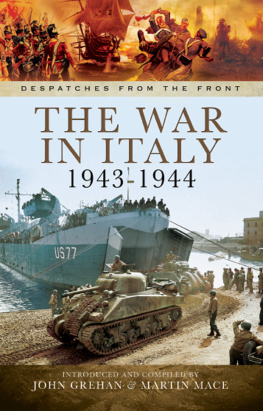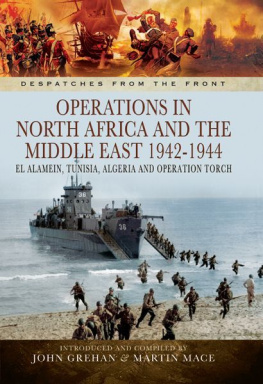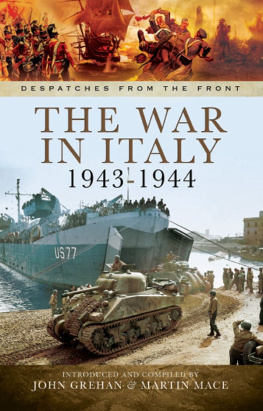First published in Great Britain in 2014 by
Pen & Sword Maritime
an imprint of
Pen & Sword Books Ltd
47 Church Street
Barnsley
South Yorkshire
S70 2AS
Copyright Martin Mace and John Grehan, 2014
ISBN 978 1 78346 222 3
eISBN 9781473837362
The right of Martin Mace and John Grehan to be identified as Authors of this Work has been asserted by them in accordance with the Copyright, Designs and Patents Act 1988.
A CIP catalogue record for this book is available from the British Library. All rights reserved. No part of this book may be reproduced or transmitted in any form or by any means, electronic or mechanical including photocopying, recording or by any information storage and retrieval system, without permission from the Publisher in writing.
Printed and bound in England
By CPI Group (UK) Ltd, Croydon, CR0 4YY
Pen & Sword Books Ltd incorporates the Imprints of
Pen & Sword Aviation, Pen & Sword Family History,
Pen & Sword Maritime, Pen & Sword Military, Pen & Sword Discovery,
Pen & Sword Politics, Pen & Sword Atlas, Pen & Sword Archaeology,
Wharncliffe Local History, Wharncliffe True Crime, Wharncliffe Transport,
Pen & Sword Select, Pen & Sword Military Classics, Leo Cooper,
The Praetorian Press, Claymore Press, Remember When,
Seaforth Publishing and Frontline Publishing
For a complete list of Pen & Sword titles please contact:
PEN & SWORD BOOKS LIMITED
47 Church Street, Barnsley, South Yorkshire, S70 2AS, England
E-mail: enquiries@pen-and-sword.co.uk
Website: www.pen-and-sword.co.uk
I NTRODUCTION
For more than 150 years the Royal Navy had been the mightiest naval power on the planet. It expected to dominate every theatre of war in which it was deployed. Uniquely, this was not the case for considerable periods of time during the Second World War in the Mediterranean. The reason for this was not the Italian Navy, which, whilst far from being an insignificant force, proved to be no match for the British Mediterranean Fleet, but because of the advent of air power.
The entire Mediterranean was within reach of Axis aircraft operating from bases across southern Europe. This situation made every excursion beyond the Strait of Gibraltar a hazardous undertaking.
That having been stated, the first major aerial strike against warships in the Mediterranean was conducted by the Royal Navy. This was by aircraft of the Fleet Air Arm against the main Italian fleet base at Taranto on 11 November 1940. It is this attack that forms the first of the Mediterranean despatches from Admiral Andrew Cunningham.
As Cunningham explains, an attack on Taranto had been considered for many months before the outbreak of war. The long delay between the planning and the execution, Cunningham relates, was because conditions and circumstances had to be absolutely ideal before the attack could be risked. There could only be one strike of the nature that was planned, as the Italians would thereafter be on their guard. Cunningham had one chance and one chance only.
Cunningham arrived in Alexandria on 5 June 1939, to take command of the Mediterranean Fleet, hoisting his flag in the battleship HMS Warspite the following day. He described his new posting as The finest command the Royal Navy has to offer and he remarked in his memoirs that he probably knew the Mediterranean as well as any naval officer of his generation.
For an attack upon Taranto to be successful, detailed and accurate reconnaissance was vital in order to determine that the principal capital ships of the Italian navy, the Regia Marina , were in the port and to pinpoint their exact berthing positions. Until the arrival of Martin Maryland light reconnaissance aircraft at Malta, no suitable planes were available to Cunningham. Seaplanes and the Fairey Swordfish were too slow, too vulnerable and too obvious to carry out such a task. They would be easily spotted by the Italians (and easily shot out of the sky) who would then be alerted to the danger of a possible air attack.
The other reason for the delay in carrying out the raid was that the strike aircraft, Fairey Swordfish, would need long range fuel tanks. These were not available to Cunningham until HMS Illustrious joined the Mediterranean Fleet in September 1940.
The raid, code-named Operation Judgement , was a remarkable success, resulting in the sinking of one Italian battleship, Conte di Cavour , with two other battleships being severely damaged. In a single night the Italians had lost half of their battleships and following the attack the remaining battleships sailed north for safety of Naples.
The immediate result of Judgement was that the balance of power had swung in favour of the Royal Navy; the Mediterranean Fleet then enjoyed more operational freedom.
Previously Cunningham had been forced to keep his fleet together to ensure that he had enough firepower to combat the main strength of the Regia Marina , but with only three battleships to oppose him, Cunningham could divide his force into two, knowing that each part was a match for the Italians.
The Taranto raid, the first major victory for naval air power in the world, is generally regarded as marking the beginning of the ascendancy of naval aviation. Indeed, According to Admiral Cunningham, Taranto, and the night of November 1112, 1940, should be remembered for ever as having shown once and for all that in the Fleet Air Arm the Navy has its most devastating weapon.
At the start of the naval war in the Mediterranean, the Regia Marina could count approximately 245 vessels of all descriptions in its fleet. Apart from the six battleships (with two other battleships nearing completion), the Italians had twenty-one cruisers, fifty-two destroyers, at least sixty large torpedo boats, and 106 submarines. This was a huge force concentrated within the confines of the Mediterranean. However, this was offset by the French Navy which had five battleships, fourteen cruisers, forty destroyers and thirty-six submarines in the region. It was only when the French surrendered in June 1940 that the Italian Navy became the dominant force in the Mediterranean.
The French withdrawal from the war left Cunningham in a difficult situation. He had under him the 1st Battle Squadron consisting of the battleships HMS Warspite , HMS Barham , and HMS Malaya , the 1st Cruiser Squadron which comprised the County-class heavy cruisers HMS Devonshire , HMS Shropshire , and HMS Sussex , the 3rd Cruiser Squadron with the light cruisers HMS Arethusa , HMS Penelope and HMS Galatea , and the 1st, 2nd, 3rd and 4th Destroyer Flotillas. In addition Cunningham had the aircraft carrier HMS Glorious , the only aircraft carrier in the Mediterranean. His entire force amounted to just fifty-nine ships.
With such a large disparity in numbers Cunningham had to do something to even up the score and the Taranto attack did exactly that. After Operation Judgement he formed two battle groups, each centred around one of his two aircraft carriers ( Glorious and Illustrious ) and two battleships. This allowed him to deploy two forces rather than the single one he had to maintain previously.
After the events at Taranto, the Regia Marina was never able to re-establish its dominance in the Mediterranean, though the aircraft of the Regia Aeronautica Italiana and the Luftwaffe presented Cunningham with an entirely different problem. This was especially evident in the evacuation of British and Commonwealth troops from Crete in May 1941. Though some 15,000 troops were rescued, the German and Italian aircraft sunk three cruisers and six destroyers, with one aircraft carrier (the recently arrived HMS Formidable ), five cruisers, five destroyers and the battleships HMS Barham and HMS Warspite being damaged.




